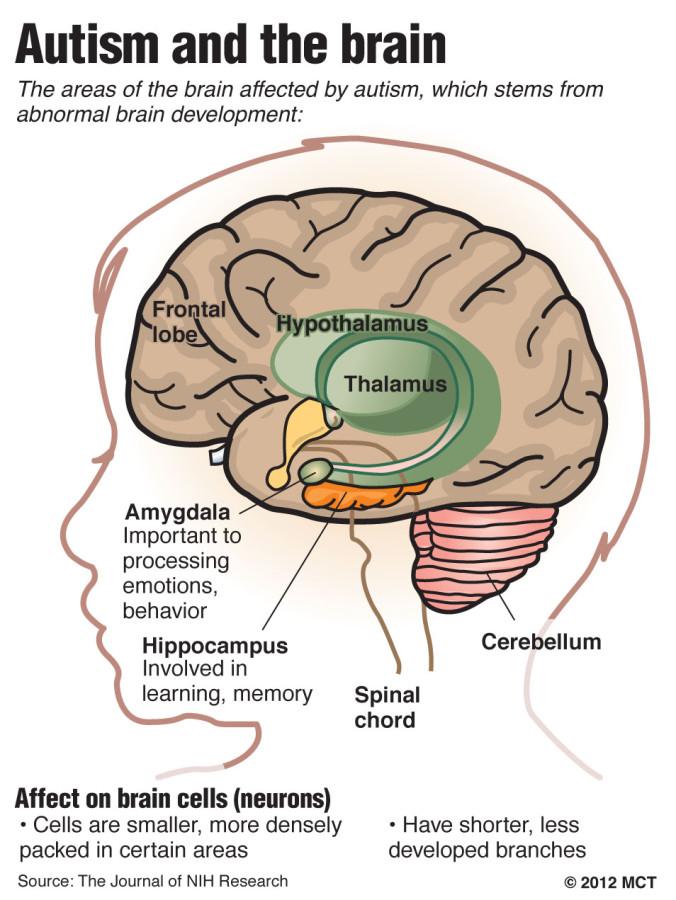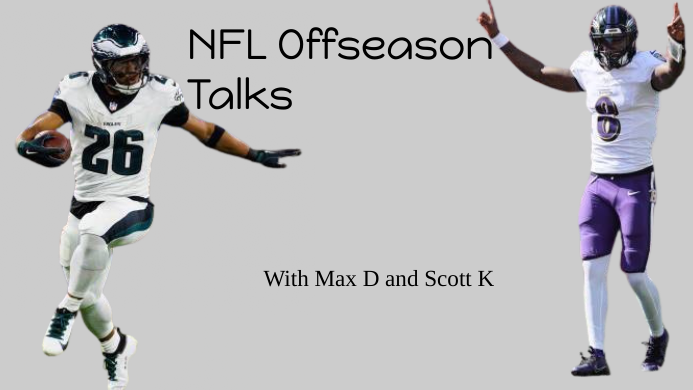Teen Communication: How to be better at talking to autistic students
Graphic shows areas of the brain affected by autism.
January 21, 2016
It can be difficult for teens to talk to adults and even to students they don’t know. Autistic students experience this difficulty in a magnified way because their specific disability directly affects communication. Making friends, which is stressful for nearly every teen, is even more difficult.
What can teens do to help autistic students feel more comfortable and successful in high school?
What is autism?
Autism is a disability that affects the areas of the brain that control communicating and cognitive functions. Because autism impacts these important areas of the brain, it can be very difficult for people with autism to function within society. Surprisingly, autism is the fastest growing neurological disorder because its clinical definition has expanded.
Today, there are many ways to help people with autism learn more about how to thrive in society. Years ago these therapy options weren’t available.
According to The Atlantic, Donald Gray Triplett, an 82 year old man with autism, had to suffer as a child, as people in that time hadn’t diagnosed autism as a disability yet. Because autism was not yet a diagnosable disability, sufferers were often regarded as awkward or nuisances. After Triplett was examined at Johns Hopkins Hospital, he was sent to an institution in Sanatorium, Mississippi, in August of 1937. Doctors claimed that if they changed the environment Triplett lived in, he would behave differently. At this time, Triplett was only 3-years-old.
Triplett’s case of autism puzzled doctors, who eventually began to wonder if he had schizophrenia. Once Triplett was taken out of the institution, his mother found Dr. Leo Kanner. Kanner had been observing other children with problems similar to Triplett’s and had began to suspect that these behaviors were symptoms of an undiscovered medical disorder. Finally, in 1943, Kanner published his findings in a journal, called The Nervous Child.
Since then, Triplett has lived in Forest, Mississippi. He has learned to drive, golf, and successfully live within society. We have learned that people with autism, given help and education, are often able to function in mainstream society.
Now, there are many therapies and services that can help people with autism. “These therapies provide structure and support; hopefully, they can provide consistency for that child,” said Karen Newman, family consultant at Monocacy Neuro-developmental Center.
Improving interaction with autistic teens
As Triplett showed, autism is unique. How severely it impacts someone varies from person to person. According to American Speech-Language-Hearing Association, there are different levels of how well a person with autism can function. Levels are based on ability to interact with others, support necessary, and repetitive behaviors.. Though someone may be labeled with “low-functioning” autism, over time that can improve with therapies and other services. Because the severity of autism may differ in specific environments or situations, it can be difficult for others to know how to interact with that person.
An article from The National Autism Society, one of the largest association of specialists, claims that many people with autism have trouble not just with verbal communication, but also with picking up social cues and understanding what that person is trying to say, or how they feel. It often helps those with autism if the person they interact with uses gestures or tries to visually show what he/she is talking about.
To help a person with autism understand better, it’s generally best to talk slightly slower and to avoid talking for a prolonged period of time. This can help that person process the information easier.
In addition, sometimes people with autism use what is called echolalia, where they repeat something they have heard. This is because they don’t know how to respond, but they realize that they should acknowledge they have been spoken to.
How teachers can help autistic students
It can be difficult for children and teenagers with autism to function in the classroom. Though the student might not ask for help, there are many ways that teachers can help autistic students learn. Many people with autism are visual learners. If a teacher is explaining a new concept, it can help if the teacher writes or draws an example. The drawing will help the student begin to interpret information from both and auditory and visual perspective.
One of the most important parts of helping and relating to others with autism is patience and caring. Learning more about autism and how it affects others can help others act with tolerance. Becoming more educated on autism can help others to learn appropriate ways to support and interact with those who have autism. Helping others with autism can be frustrating and challenging, especially for parents of a child with autism, but those with autism deserve respect and love.
Myths: What causes autism?
Rumors and misinformation spread like wildfire. Many of these beliefs have been proven wrong, or are just plainly impossible.
For example, many parents believe that the MMR (measles, mumps, and rubella) vaccine that is given to children causes autism. In 1998, Andrew Wakefield, and 12 of his colleagues, performed many experiments to prove this theory. After all data was collected, Wakefield published the findings in the Lancet. Wakefield and his colleagues were found guilty of creating false data to support the claim. Though all claims have been found inaccurate, many people still believe that the MMR vaccine causes autism.
Another myth is that parents who are “cold” or distant to their children are more likely to have a child with autism. The cause is not lack of communication, but a lack of communication after a diagnosis can slow the a autistic child’s progress.
Temple Grandin: Autism from the mind of the autistic
Temple Grandin is an autistic woman who has excelled in learning about how different types of brains work. In a TED Talk, Grandin explained a variety of ways the autistic brain works. She claims that people with autism are photo-realistic thinkers: thinkers think in pictures, not in language. Grandin describes being a photo-realistic thinker as “looking through Google Images,” explaining that multiple images pop up for just one subject.
Grandin worries that schools are becoming too “abstract.” She believes that autistic people are hands-on, needing to be able to see what is happening. As society is focusing more on sciences, “I’m worried that the schools are taking out the hands-on classes…the ones that I excelled in,” said Grandin.
In conclusion, autism is a neurological disorder that often hinders effective communication. There are many ways to support a person with autism: practice tolerance and stay educated, be mindful of everyone’s needs, and recognize the importance of patience.
“To measure the success of our societies, we should examine how well those with different abilities are integrated as full and valued members.” -Ban Ki-moon







Eileen King • Jan 25, 2016 at 9:40 pm
A thoughtful article on the difficulties those with autism face when coping with the world around them. The suggestions for helping and understanding ways to communicate are sure to be very useful when interacting with these teens and others. Sianna is to be commended for her dedication to this subject.